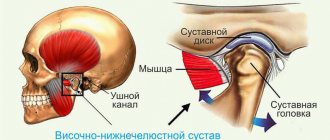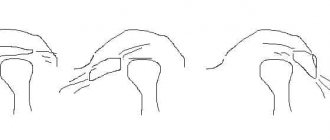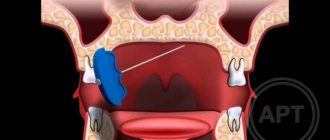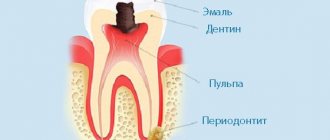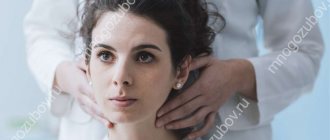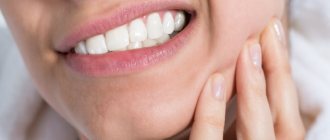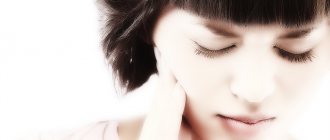Many of our patients (as well as patients, for example, of chiropractors or neurologists) do not even realize how interconnected the problems they are being treated with are. For example, the jaw joint hurts, the head hurts, shooting in the ear, clicking in the jaw, pulling at the base of the skull... it would seem that these are different symptoms, but the reason may be the same for everyone: TMJ dysfunction
.
Functions of the TMJ
TMJ
or
temporomandibular joint
is a joint located above the ear that connects the temporal bone to the lower jaw and the lower jaw to the skull. The muscles that are attached to this joint are actively involved in speaking, facial expressions, chewing, and swallowing. Together, muscles, ligaments, cartilage and joints make up the apparatus, thanks to which we can generally open and close our mouth, move our jaw back and forth and left and right, and the load on this apparatus is significant - comparable to the load, for example, on the knee joint.
The temporomandibular joint is the only paired and symmetrically moving joint in the human body, and problems with its functioning lead to numerous unpleasant diseases. TMJ dysfunction—limited work and mobility of the jaw joint—occurs when the joint on the right and left sides of the skull does not move synchronously or evenly. For example, to open the mouth, the patient must first move the lower jaw from side to side, “until it clicks.” Or when you open your mouth, you feel pain in your jaw or temples.
This disease has many names: arthritis (arthrosis) of the TMJ, myofacial syndrome, myoarthropathy of the TMJ, chronic dislocation of the lower jaw, Costen's syndrome (named after the American doctor who first identified this disease). This pathology is difficult to diagnose and treat, and at the same time it can cause a wide variety of pain - from headaches to neck pain.
Statistical fact: from 30% to 70% of dental patients suffer from functional pathology of the temporomandibular joint. And these are not always older people, as one might expect. On the contrary, people of all ages, including children, suffer from TMJ pain and related pain.
TMJ dysfunction was first described by otolaryngologist (ENT doctor) Kosten in 1934. Kosten studied pain and noise in the ears and burning in the nose, which intensified during or after eating, and was the first to think of linking them with malfunction of the temporomandibular joint. Subsequently, his colleagues and other doctors who examined this problem expanded and supplemented the list of symptoms. Now this list is quite extensive, and often not all symptoms can be associated specifically with TMJ problems.
Treatment procedures and methods of prevention
Depending on the diagnosis, our otolaryngologist
will recommend certain procedures to you as an important addition to the treatment of ear pain due to cervical osteochondrosis. For example, a doctor may recommend physical therapy (usually heating), manual therapy, which is aimed at reducing pain directly in the neck. Among the methods of alternative medicine, acupuncture stands out. It is always easier to prevent any disease in time than to treat it, so avoid hypothermia, monitor your diet, and pay enough attention to rest and sports. And, of course, do not let the situation take its course if you have already discovered the first warning symptoms.
Symptoms of TMJ dysfunction
- Pain in the jaw, increasing when opening the mouth, chewing, speaking, yawning;
Clicking in the joint of the lower jaw, the jaw “jams”, it does not open, does not close, or has begun to close differently;- Pain in the temples, in the eye area, visual impairment, photophobia (sensitivity to light);
- Pain, ringing and noise in the ears, in the ear area, feeling of pressure in the ears;
- Frequent headaches, dizziness, migraines;
- Sleep disorders, insomnia, anxiety, depression;
- Pain in the neck, in the lower part of the skull;
- Tooth pain from sweets, hot, cold.
This diversity in symptoms, which often makes it difficult for doctors to diagnose, is explained by the fact that the joint is connected to many important organs and parts of the body (eyes, ears, neck, head) and errors in its functioning can affect everything at once, or they can only affect something one. It is usually possible to determine that the problem is in the temporomandibular joint only in a complex manner.
In most cases, TMJ dysfunction is manifested by pain in the face, joints of the jaw, neck, shoulders, ears, crunching and clicking. Complaints of dizziness, difficulty chewing food, speech and hearing disorders, difficulty opening the mouth, “jamming” of the jaw, or even the appearance of swelling and fever are also common.
TMJ dysfunction - causes and consequences.
Orthodontist-dentist Nikolaeva Nadezhda Nikolaevna
The temporomandibular joint ( TMJ ) is a paired joint formed by the head of the mandible, the mandibular fossa and the articular tubercle of the temporal bone. The heads of the mandible meet at an obtuse angle at the anterior edge of the foramen magnum. The TMJ ensures the movement of the lower jaw and represents a complex activity of the body in the form of chewing, swallowing, talking, yawning. The muscles of mastication ensure precise movement of the joint in an error-free manner, unless there is dysfunction ( TMJ )
. According to WHO, about 40% of the population aged 20-50 years suffer from TMJ . But not every person seeks help from a gnathologist or osteopath with complaints about the joint, preferring to visit other doctors with headaches, fatigue, attacks of fear, pressure... Dysfunction manifests itself in the form of a neurological clinic: headache, dizziness, clicking and crunching joint, muscle tension, spasms in the head, neck, throat. Otology clinic: noise, ringing, ear congestion, hearing loss. But there are other, hidden and long-term consequences of TMJ dysfunction:
- Cervical lordosis. Poor posture, when the neck is excessively straightened or, on the contrary, the head protrudes noticeably relative to the person’s body.
- Curvature in the sacroiliac joint (pelvic bones) as a result, a change in the length of the limbs.
With pain and dizziness, it would seem clear: head, ear, joint. Everything is close, everything interacts. But what effect does TMJ on the entire musculoskeletal system, especially on the length of the limbs?
The TMJ is the structure of one complex - the DENTAL GNOSTIC system. The dental system is a complex of interactions between the structures and functions of the head and neck. Includes components of the bones of the skull, lower jaw, hyoid bone, clavicle and sternum, muscles and ligaments, joints, vascular, lymphatic and nervous systems, as well as soft tissues of the head and teeth. In addition, it has a connection with the sacrum and coccyx through the dura mater. Everything in the system is interconnected and depends on the normal functioning of all its parts.*
Main functions of the dental system:
- Providing basic body functions: chewing, swallowing, biting, speaking, breathing.
- Participation in maintaining statics: gait mechanism, cervical, vertebral and muscle balance, pelvic balance, equilibrium.
- Effect on cranial (cranial) function - especially the temporal bone.
- Influence on the functions of the nervous, endocrine, lymphatic systems.
Let's look at the basic functions of the body: chewing, swallowing, speaking, breathing. These basic body functions are performed through the movement of the lower jaw. The movement of the lower jaw is ensured by the movement of the head of the lower jaw in the articular fossa of the TMJ , with the help of the temporal, masticatory, pterygoid, hypoglossal and other muscles. The line of closure of the teeth - the occlusal plane, or simply the bite, should normally be parallel to the planes of the entire musculoskeletal system. The main planes of which pass through the pupils, the line of closure of the teeth, the second and third cervical vertebrae, shoulder blades, iliac crests, knees and ankles. The parallelism of the lines indicates the health of the musculoskeletal system and the dental system. A change in any of the planes leads to changes in the other planes. Therefore, a violation of the occlusal plane relative to others can cause pain and negative changes in completely unexpected parts of the body.
Violations of occlusion as a result of tooth wear, congenital malocclusion, and more often, inadequate dental treatment or prosthetics, inept use of braces, illegal removal of healthy teeth, lead to response disorders in the cervical spine and spasm of the muscles of the back of the neck. Prolonged spasm causes structural changes in the muscle, shortening it and causing it to lose its ability to contract and relax. Muscle spasm leads to spasm of the chewing and facial muscles. Thus, for the body, muscle spasm on one side is a pathological process that leads to spasm in another area. For example, the temporal muscle is involved in supporting statics; the masticatory muscles are its synergist. These muscles contain a large number of proprioceptors (sensory fibers). A constant flow of nerve impulses from proprioceptors is involved in the regulation of the vertical position of the body. Violation of occlusion (bite) leads to unbalanced movement of the lower jaw and maxillofacial muscles, incl. masticatory and temporal muscles. A change in the flow of nerve impulses, due to dysfunction of the TMJ , causes curvature of the spine in the cervical region and sacroiliac joint, which leads to twisting of the pelvis and changes in the length of the limbs.
An imbalance in the TMJ sends a negative stimulus to the nervous system 24 hours a day, 7 days a week. Any malocclusion changes the direction of force in the skull. For example, premature contact on the lateral teeth causes uncoordinated muscle movement and distortion of nerve impulse transmission to the brain. Uncoordinated muscle movements often cause tension in the fascia of the neck. The nodes of the sympathetic trunk of the autonomic nervous system lie anterior to the prevertebral fascia of the neck. Thus, dysfunction of the TMJ , causing tension in the fascia of the neck, can irritate cervical sympathetic communications, provoking a reflex spasm of the vessels of the head. Spasm of the blood vessels in the head causes a disturbance in the blood supply to the cerebellum, which is manifested by a lack of coordination, dizziness - as a result of anxiety. TMJ dysfunction causes torsion (torsio; Latin “rotation, twisting”) of the temporal bone, in which the labyrinth with the vestibular apparatus is located. Changes in the vestibular system lead to imbalance and dizziness. Nasal congestion may also be associated with TMJ . Due to the shortening of the fascia of the neck muscles, there is a violation of lymphatic drainage and the outflow of venous blood from the head. This may manifest itself in the form of tissue edema in the area of the nasal passages, since this area is rich in blood vessels. Diseases of the temporomandibular joint have the following causes :
- Malocclusion (occlusion) is a closure of the teeth, which disrupts the shape and function of the dental system. This manifests itself in the form of deformation of the occlusal surface of the teeth with blockade of the movement of the lower jaw. Which can lead to pathological wear of teeth, functional overload of the TMJ and chewing muscles. The most common TMJ problem is a decrease in bite height. This is due to several factors: impaired teething, bruxism, premature loss of milk or permanent teeth, congenital absence of a group of teeth, microdontia (small teeth), pathological abrasion of enamel, violation of the vertical size of teeth due to the work of the dentist. Changes in the position of the TMJ due to illiterate orthodontic treatment, illegal or forced removal, tooth decay.
- Stress (overexertion, strong clenching of teeth).
- Jaw trauma (fractures of facial bones and jaw).
- Endocrine, metabolic disorders, infectious diseases.
- Excessive physical activity.
- Bad habits (biting nails, holding the phone incorrectly, etc.)
Symptoms of temporomandibular joint diseases:
- Headache, spasms in the facial muscles and jaw area.
- Clicking, crunching, grinding when the jaw moves.
- Pain, congestion and ringing in the ears.
- Enlarged submandibular lymph nodes.
- Dizziness.
TMJ diseases on human health is far from being studied, in contrast to the methods of diagnosis, treatment and restoration of TMJ by a doctor. In most cases, a transparent corrective aligner is enough to save yourself from many present and future health problems.
Pain in the jaw joint: causes
- Defects in the dentition - lack of teeth, overestimation of fillings;
Pathological abrasion of teeth;- Broken bite
;
- Overload of the masticatory muscles (for example, if you chew on only one side for a long time);
- Inaccurate prosthetics, errors in orthodontic treatment;
- Other anomalies of the oral cavity and jaw structure;
- Bruxism, involuntary grinding of teeth.
- Birth trauma, trauma to the skull and jaw;
- Osteochondrosis and scoliosis of the spine;
- Severe constant stress
;
- An infection in the joint cavity that provokes inflammation of the TMJ.
Diagnostics and x-ray of the temporomandibular joint
Diagnosis of TMJ when it is dysfunctional is difficult due to the variety of clinical complaints. This leads to the fact that the patient can undergo examination by different specialists for a long time, wasting time. A full examination is carried out by dentists
(primarily an orthopedist or orthodontist) and neurologists.
Diagnosis with the naked eye is difficult, and TMJ problems can only be directly noticed if the malocclusion is clearly visible. Most often, dysfunction of the temporomandibular joint is associated precisely with disorders of bite and jaw closure.
The most reliable and effective way is to conduct x-ray diagnostics and orthopantomogram
jaws. In some cases, an MRI may also be done.
Treatment of the temporomandibular joint
Complex treatment of TMJ is possible only in dentistry, and is possible thanks to:
- surgery on the lower jaw;
- orthodontic treatment
(prescribing special trainers that will be worn at night and reduce pain by adjusting the load on the joint - the same trainers are recommended for bruxism) and bite correction with braces;
- orthopedic treatment
and
implantation
(insert a suitable prosthesis to restore the correct closure of the jaws).
Treatment is always prescribed individually, based on the results of an examination by an orthodontist, and is most often carried out comprehensively. It is dangerous to neglect TMJ diseases: this can lead to arthrosis, in which connective tissue grows in the joint cavity, which, in turn, threatens complete immobilization of the joint (ankylosis).
Severe pain and joint spasms can be relieved with compresses and painkillers; Stresses that provoke tension in the joint can be relieved with sedatives, but all these are half measures that do not treat the root cause of the pain.
What diseases cause pain
| Name of the disease | Symptoms |
| Disc herniation in the cervical spine | Causes nagging pain in the shoulder joint and neck, headaches and dizziness. A person feels a decrease in hand sensitivity. This happens due to a pinched nerve root. |
| Cervical osteochondrosis | Severe acute pain in the neck, which radiates to the arm and intensifies when turning the head. |
| Spinal canal stenosis | Causes numbness in the arms and upper body, weakness, and disruption of brain function. |
| Muscle spasm | Occurs due to overstrain of the neck muscles, when being in an uncomfortable position or during prolonged work at the computer. It occurs suddenly and causes severe pain. |
| Cervical radiculitis, discogenic pain syndrome | It occurs due to compression of the nerve root by a herniated intervertebral disc during sudden movements of the head. Accompanied by severe neck pain that does not go away for 3 or more days. Often the neck becomes immobilized. |
| Cervical spondylosis | Causes chronic, aching pain in the neck, shoulder, or arm that can last for months. The disease causes severe deformities of the vertebrae. |
| Inflammation of the tendons of the shoulder joint | Inflammation from the shoulder joint spreads to the surrounding muscles and neck muscles, restricts movement in the neck, causes periodic nagging pain and can provoke the development of cervical osteochondrosis. |
Other causes of neck pain: cervical myositis, instability of the cervical vertebrae, glenohumeral periarthritis, disc protrusion in the cervical spine, consequences of birth injuries, scoliosis, displacement of the cervical vertebrae (listhesis).
